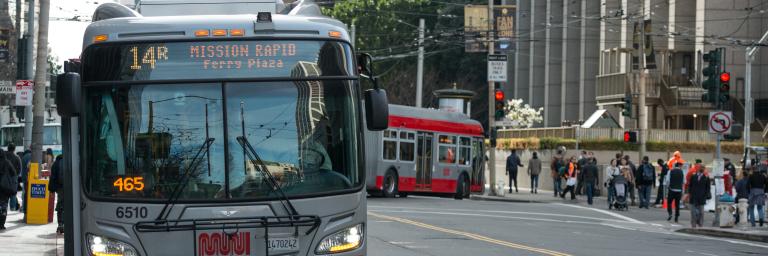On June 15, 2021, the SFMTA Board of Directors permanently approved the full-time transit lanes on Mission Street in SoMa. For more details, check out the staff presentation and report from the board meeting.
As traffic congestion returns, the SFMTA is working to protect San Franciscans who continue to rely on Muni to get to work and essential appointments during this pandemic. If just a fraction of the people riding transit before the crisis begin driving alone, traffic congestion will be so severe that it could paralyze the city’s economic recovery. Without action, transit-dependent San Franciscans will bear the costs of traffic congestion, like an increased risk of exposure to COVID-19 on slower, more crowded buses.
Along with other key locations across the city, the SFMTA approved to install temporary (now permanent) emergency transit lanes on segments of the 14 Mission and 14R Mission Rapid to keep buses out of traffic and reduce crowding and travel times. Both routes have been a lifeline for essential trips during the pandemic and have experienced crowding despite increased service. By reducing delay from congestion, Muni can provide more frequent service and greater capacity with the same number of buses.
Locations of proposed temporary transit lanes were chosen based on current ridership and travel time data. Providing service improvements to customers on Muni routes that serve neighborhoods with high percentages of people of color and low-income households is a top priority.
Transit Lane Scope: Mission Street SoMa
As part of the Temporary (now permanent) Emergency Transit Lanes, a full-time transit lane replaced the existing weekday peak period transit lanes on Mission Street from 11th Street to 1st Street. Currently serving Muni routes 14 Mission and 14R Mission Rapid in addition to Golden Gate Transit and SamTrans, the full-time transit lane will help move buses more quickly and reliably along this busy downtown corridor.
In addition to installing the full-time transit lane, the travel lanes were widened to better accommodate the buses. The lanes on Mission Street were too narrow to accommodate traffic and buses which has contributed to unsafe street conditions and 225 collisions involving transit in the past five years.
When the full-time transit lanes were installed, parking and loading zones were adjusted, with parking and loading removed from one side of the street on each block to provide space for buses to move more efficiently and help traffic flow. One lane of parking and loading was maintained on each block and restored to 24/7 use from the former part-time tow-away.
Street improvements:
- Install temporary 24/7 bus lanes (replaces part-time bus lanes)
- Convert part-time tow-away to 24/7 tow-away on one side of Mission Street
- Restore 24/7 parking on other side by eliminating part-time tow-away
- Widen lanes to accommodate buses
Implementation and Sunset Date
The initial group of temporary emergency transit lanes was approved by the SFMTA Board of Directors on June 30, 2020. Based on ridership and travel time data, these transit lanes will benefit customers on five Muni routes which are critical to neighborhoods with high percentages of people of color and low-income households.
On Mission Street, the temporary emergency transit lanes were installed in late summer 2020, and were striped only with white paint and “Bus/Taxi Only” stenciling and signage, making them easily reversible. On June 15, 2021, the SFMTA Board of Directors permanently approved the full-time transit lanes on Mission Street. For more details, check out the staff presentation and report from the board meeting.
Outreach and Evaluation
The urgent nature of this emergency called for putting temporary measures into place, directly on the street. This accelerated approach allowed the city to respond quickly to protect public health and support economic recovery while we worked with the community to evaluate and make adjustments to the temporary transit lanes in real time. Areas of evaluation included, but were not limited to:
- Health and safety benefits
- Economic health
- Neighborhood impacts and equity
- Transit performance
- Traffic safety
Community-based organizations, stakeholders and neighbors were involved in shaping the framework and process for evaluating and adjusting the emergency transit lanes in real time. Both qualitative and quantitative data were collected after implementation and continue to inform as-needed changes to the transit lanes.
How we evaluated and collected feedback
After the temporary emergency transit lanes were installed, we evaluated the effectiveness by looking at the results from both a community survey and a technical evaluation of the lanes. Sign up for project updates to stay up to date.
